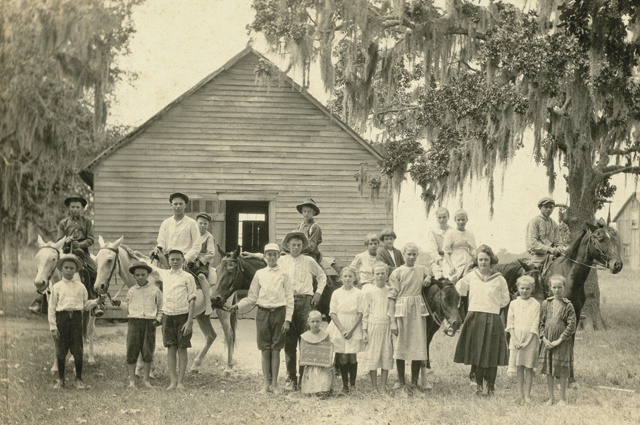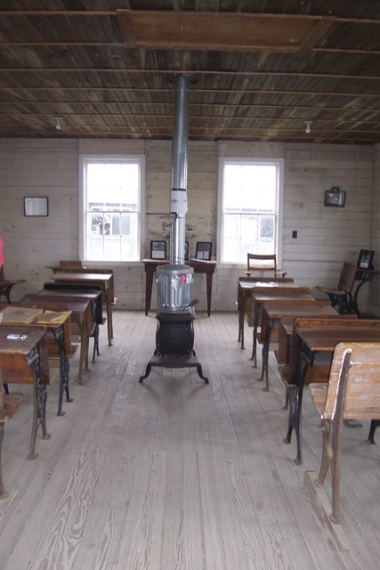I thought time travel happened only in novels and movies until I visited Zimmerscheidt School, which is thought to be the oldest one-room schoolhouse in Texas. In the rustic wooden building, a stone’s throw north of Columbus, I met silver-haired former students and their families and listened as their stories carried me back to the days when a lone teacher taught 20-odd students in seven grade levels. Their warm-hearted tales made it easy to imagine a long-ago time when schools offered a different educational experience that involved the entire community.
Zimmerscheidt School—first built in 1857—is a small, rectangular building with a wood-burning stove in the center and windows on three sides to let in natural light. It is beside a narrow farm road in the once-thriving community of Zimmerscheidt, which is in the San Bernard Electric Cooperative service area. Children worked here on lessons without the benefit of electric lights or running water for nearly 100 years. Desks with scrolled iron legs form rows below a painted wooden blackboard, and shelves hold library books long out of circulation, such as Rudyard Kipling’s Soldiers Three, published in 1888. The feeling of fellowship among former students is strong. This old schoolhouse is where they learned not only reading and writing but also the morals and values of their community.
Leroy Weishuhn, trim and only slightly bent at 94, tells me he walked a mile to school beginning when he was 7 years old and continuing through seventh grade. He remembers the old school with fondness. “Things were different then,” he says. “We carried our drinking water in a bucket from the neighbor’s well each morning, and the bathrooms were outdoor privies. Still, we got a good education even though our teacher taught seven grade levels at once.”
One group of students traveled to school in a hack (two-seated buggy) pulled by an old mule—the predecessor of a modern school bus. Others rode horses. “They tied their horses to the hackberry trees out front,” Weishuhn remembers. “Some of the kids opened and closed gates along the way because there weren’t many public roads, and they had to cross private property to get to school. In cold weather, we gathered dry broom weeds on the way to school to start a fire in the woodstove.”
Weishuhn’s memory for details from his school days is astonishing. “My first-grade teacher, Miss Landig, couldn’t go home at night because unmarried female teachers were supposed to be supervised,” he recalls, “so she boarded and took her meals with the family of one of the students.” Landig’s salary of $70 a month was a significant increase over the previous teacher’s $40. On a scrap of paper, Weishuhn lists the first and last names of each teacher from his seven years of schooling. “We had almost all nice teachers here,” he says.
Named for Frederick A. Zimmerscheidt and his wife, Margaret, who arrived in Texas in 1832 and founded, with other families, the first German settlement in the area, the school drew students from up to 6 miles away. “My great-grandfather, J.F. Leyendecker, attended the school the first year it opened and said that classes were taught in German the first few years,” Mary Anne Pickens remembers. Pickens’ father, grandparents and great-grandfather all attended Zimmerscheidt School. Although not a former student herself, she treasures her grandmother’s 1898 geography textbook. “My grandparents boarded the teachers at times,” she says. “Families were large in those days, and the teacher had to share a room.”
Stories of classroom discipline shared a common thread. “I don’t remember much bad behavior at school,” Weishuhn says. “We were mostly all nice kids, and the teachers didn’t have no trouble with us. But when I was in second grade, we had a mean teacher who made kids stand in the corners. Every corner was filled. So one day, when she had to go to the privy out back, we all went home. Of course, our parents made us go back the next day,” he says, smiling at the memory.
“Our desks were homemade when I went to school here,” Weishuhn recalls. “Everyone brought lunches from home, including the teacher, and we ate in the schoolyard in nice weather. Very few kids went beyond the seventh grade. We were all farm kids and were needed to work.”
Zimmerscheidt School burned sometime before 1884 but was rebuilt across the road. It continued to function as a neighborhood school, without electricity or running water, until 1948, when it was consolidated with the Columbus Independent School District. Billie Halamicek was one of the last students to attend. “There were only four of us in 1948,” she remembers, “and we were all in different grades. After the school closed, we rode the bus to Columbus.”
Teacher Tennie Kickler Gross, now deceased, began her career at Zimmerscheidt School in 1933 and left handwritten memories of her experiences. “We taught the three R’s … correlated with history, English, geography, agriculture and health,” she wrote. “Our enrollment was too small to compete in sports with other schools. We played baseball, volleyball and yard games during our recreational period.” Weishuhn remembers his favorite game as “dog and rabbit” which, as you might imagine, involved a lot of chasing.
Teachers had little time to provide individual attention; teaching lessons and listening to recitations on seven different grade levels each day kept them busy. “We each had seven textbooks on different subjects provided by the state,” Weishuhn says, “and there was a set time during the day to work on every subject. We had to carry some of the books home at night to do our homework.”
Decisions about the school fell to three men appointed by the community as trustees. The trustees were farmers in this small agricultural community, and the school year matched the agricultural schedule. “The year started on the first of October after harvest and went for nine months straight when I started first grade,” Weishuhn says.
In 1948, four years after Weishuhn returned from military service during World War II, Zimmerscheidt School added a building for use as a veterans vocational school, where he attended night classes in welding, electricity, carpentry and agriculture. Community activities were held in the evenings at the schoolhouse. Some aided the war effort and included wrapping bandages for the Red Cross.
Since 1974, the building has benefited from restoration projects. In 2010, the title of the school and land was transferred to Friends of Zimmerscheidt Historic School, a nonprofit organization.
“Restoring the school was a labor of love which served two purposes,” says Patti Glaeser, chairwoman of the Friends of Zimmerscheidt School. “It kept the building and its history intact for future generations, and it drew the community together, renewing close ties that were once such an important part of Zimmerscheidt School.”
Inside the old building, the smell of chalk, old textbooks and youthful high spirits still clings to the walls. As if by time travel, Zimmerscheidt still broadens minds in the 21st century.
——————–
Martha Deeringer, frequent contributor




